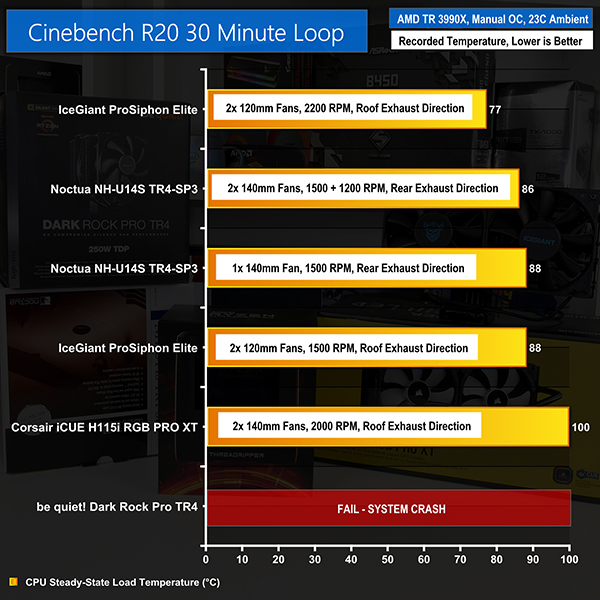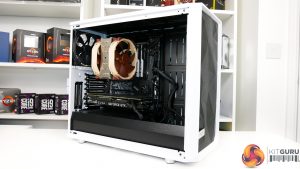Our manual CPU overclock performance test highlights each cooler operating with the CPU manually overclocked to 3.6GHz using 1.075V UEFI-set voltage and Mode 2 LLC. Cinebench R20 all-core load loops for 30 minutes.
Ambient temperature is 23°C and varies by no more than +/-1°C. Figures reported are read temperatures, not deltas.
With our frequency-locked, and therefore somewhat power-locked, manual overclock test mode, we see significant temperature differences between the coolers tested.
The coolest operator here, and this time by a notable margin, is the IceGiant ProSiphon Elite with its 2200 RPM fans. A result of 77C on 128 threads loaded at 3.6GHz is exceptionally good and highlights clear headroom to overclock further.
Reduce fan speeds to 1500 RPM and the temperature increases to 88C accordingly. This test configuration with fans reduced to 1500 RPM is perhaps unfair towards the ProSiphon Elite as it is a performance orientated cooler with a dense fin array that will be disproportionately impacted by the lower fan speeds.
Switching focus to the Noctua NH-U14S TR4-SP3, we see another strong showing that is arguably as impressive as the numbers from the IceGiant cooler. Sub-90C is a good showing and the fact that Noctua achieves this with one or two low speed fans will undoubtedly appeal to quiet cooling aficionados.
The Corsair 280mm unit just about manages to keep our chip at 100C steady state (with a few jumps to 101C or 102C). And that is with dual 2000 RPM ML140 fans running flat-out. For long-term usage, we would actually go as far as reducing the overclock very slightly to better ensure long-term stability.
The dual tower be quiet! Dark Rock Pro TR4 failed this test as the power usage from the CPU was too high and the system crept up towards 110C and crashed after less than 10 minutes of loading. There is absolutely no need to criticise the be quiet! cooler as this is undoubtedly a rather extreme test case. With that said, Noctua’s similarly priced unit did not present instability during our testing.
As a side note, we also tried this test with the Cooler Master Wraith Ripper and the time to system crash through processor overheating was in the order of seconds, not minutes. I guess be quiet! can take some positives from the fact that its cooler is superior to the expensive and loud Cooler Master unit, based on our limited testing for the Wraith Ripper in this environment.
 KitGuru KitGuru.net – Tech News | Hardware News | Hardware Reviews | IOS | Mobile | Gaming | Graphics Cards
KitGuru KitGuru.net – Tech News | Hardware News | Hardware Reviews | IOS | Mobile | Gaming | Graphics Cards




